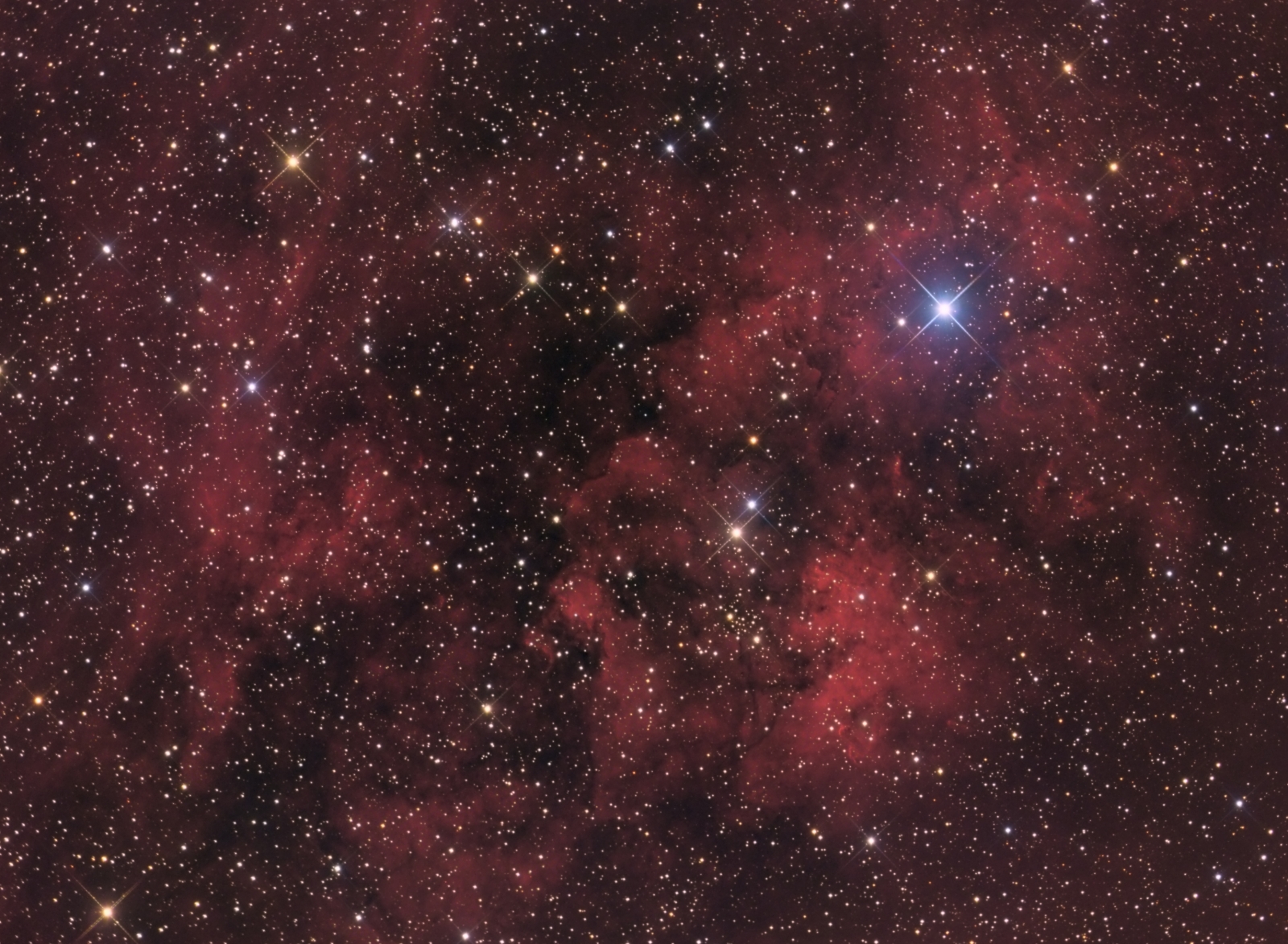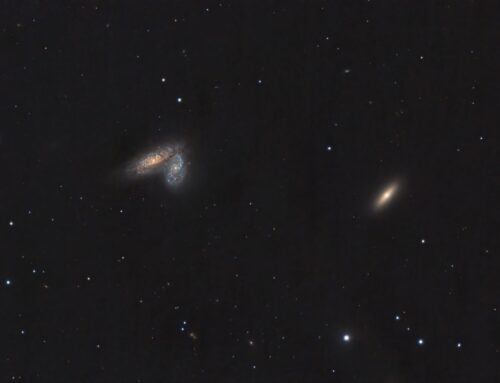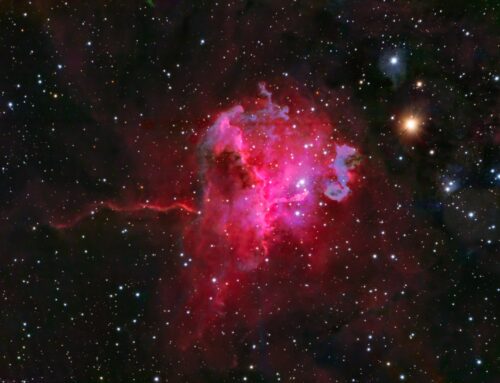Sh2-115 Emission Nebula (Colour)
 Click image for full size version
Click image for full size version
July 21, 2015
Sh2-115 is in the right half of the image, with most of Sh2-116 towards the left. Both are members of the Sharpless catalogue of nebulae and lie in northern Cygnus, not far from the famous North America nebula. They lie about 7500 light years away. At the distance of this nebula, this image spans about 120 light years from top to bottom. The red glow is powered by the stars in the open cluster Berkely 90, which is slightly to the lower right of centre in this image. The stars’ energy is exciting hydrogen electrons which then release red light when they drop back to their normal energy state.
This image blends the typical red, green and blue colour channels with data collected through the deep red hydrogen-alpha filter. This object also looks beautiful in black and white.
Tekkies:
SBIG STL-11000M camera, Baader Ha, R, G and B filters, 10″ f/6.8 ASA astrograph, Paramount MX. Guided with STL-11000’s external guider and 80 mm f/6 Stellar-Vue refractor. Acquisition and guiding with TheSkyX. Focusing with FocusMax. Automation with CCDCommander. Calibration, cosmetic correction, registration, integration and all processing in PixInsight. Shot from my SkyShed in Guelph, Ontario. Nearly full Moon for Ha and no moon for RGB. Good to very good transparency and good to very good seeing throughout acquisition.
8x15m R, 8x15mG, 5x15mB and 13x30m Ha unbinned frames (total=11hr45m).
HaRGB
Creation and cleanup: Ha, R, G and B masters were cropped and processed separately with DBE. R, G and B were combined to make an RGB image which was processed with DBE and ColourCalibration. The NB-RGBCombine Script was applied with default settings to produce a linear HaRGB image.
Linear Noise Reduction: MultiscaleLinearTransform was used to reduce noise in the background areas. Layer settings for threshold and strength: Layer 1: 3.0, 0.5 Layer 2: 2.0, 0.35 Layer 3: 1.0, 0.2 Layer 4: 0.5, 0.1
Stretching: HistogramTransformation was applied to make a pleasing yet bright image. TGV Noise was applied and the image was re-stretched to reset the black point.
Synthetic Luminance:
Creation and cleanup: The cleaned up Ha, R,G and B masters were combined using the ImageIntegration tool (average, additive with scaling, noise evaluation, iterative K-sigma / biweight midvariance, no pixel rejection).
Deconvolution: A copy of the image was stretched to use as a deconvolution mask. A star mask was made from unstretched SynthL to use as a local deringing support. Deconvolution was applied (100 iterations, regularized Richardson-Lucy, external PSF made using DynamicPSF tool with about 20 stars; local deringing at 70% and global dark deringing at 0.02).
Linear Noise Reduction: MultiscaleLinearTransform was applied to reduce the noise. Layer settings for threshold and strength: Layer 1: 3.0, 0.5 Layer 2: 2.0, 0.35 Layer 3: 1.0, 0.2 Layer 4: 0.5, 0.1
Stretching: HistogramTransformation was applied to make a pleasing yet bright image. TGV Noise was applied and the image was re-stretched to reset the black point.
Combining SynthL with HaRGB:
The luminance channel of the HaRGB image was extracted, processed and then added back into the HaRGB image as follows:
1. Extract luminance from the HaRGB image.
2. Apply LinearFit using SynthL as the reference.
3. Use ChannelCombination in Lab mode to replace the HaRGB’s luminance with the fitted luminance from step 2.
4. LRGBCombine was then used to make a SynthLHaRGB image.
Final Processing
Overall contrast was increased and brightness increased slightly with the Curves tool. Saturation in nebula and stars was increased slightly
Star shapes were smoothed and sizes reduced by applying MorphologicalTransformation twice through the same star mask. The first pass used the Midpoint operator, with default settings. The second pass used the Erosion operator with a strength of 0.17 and 4 iterations.
Image scale is about 1.1 arcsec per pixel for this camera / telescope combination.






Leave A Comment